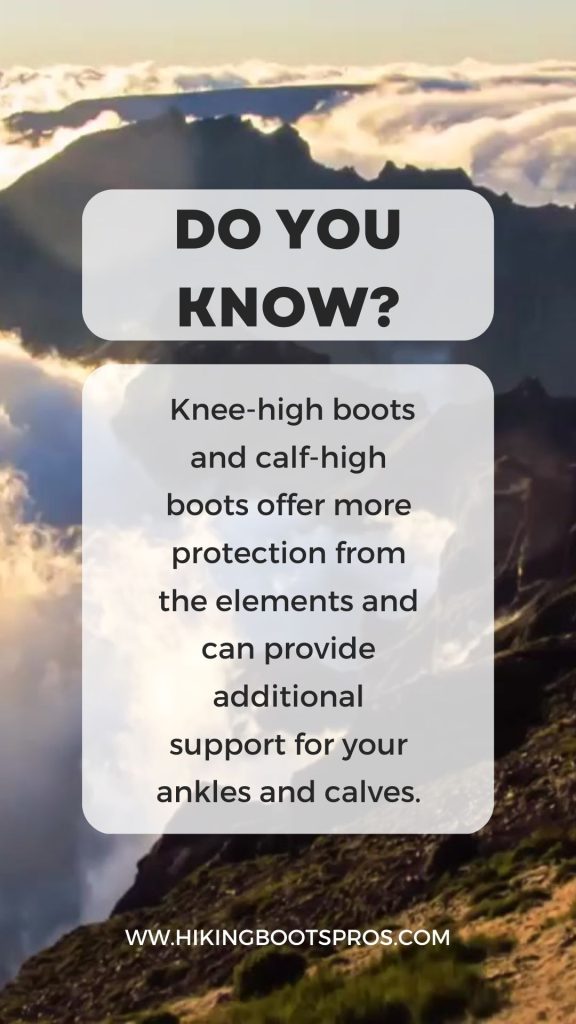Last updated on May 8th, 2023
When it comes to choosing the right pair of boots, one important factor to consider is the height of the boot. Do taller boots offer better protection and support, or are shorter boots just as effective?
In this blog post, we’ll explore the importance of boot height and how it can affect your performance, comfort, and style. We’ll also compare the differences between 6-inch and 8-inch boots and provide tips on how to determine if your tall boots are too tall.
So, whether you’re shopping for hiking boots, work boots, or fashion boots, read on to learn more about the benefits and drawbacks of taller boots.
Are Taller Boots Better?
The answer to this question depends on the purpose of the boots. Taller boots can provide additional support and protection to your ankles, calves, and shins, making them ideal for hiking, working in hazardous environments, or riding motorcycles.
They can also help keep your feet and legs warm and dry in wet or cold conditions. However, taller boots can also be heavier, bulkier, and less flexible than shorter boots, which can affect your mobility and comfort.
Additionally, tall boots may not be suitable for certain activities or foot shapes, as they can cause rubbing, chafing, or discomfort.
Does Boot Height Matter?
Yes, boot height can make a difference in how well your boots perform and how comfortable they feel. Generally, the taller the boots, the more support and protection they offer.
Knee-high boots, for example, can help prevent ankle sprains and shin injuries by stabilizing your lower leg. However, tall boots can also restrict your range of motion, making it harder to bend, squat, or climb.
For this reason, some people prefer mid-calf or ankle-height boots that provide enough support without limiting their movement.
How Do You Know If Your Tall Boots Are Too Tall?
If your boots are too tall, you may experience discomfort, rubbing, or blisters on your ankles, shins, or calves. Your boots should fit snugly around your ankles and provide enough space for your calves to move freely.
If you feel like your boots are rubbing against your skin or restricting your movement, they may be too tall or too tight.
You should also consider the purpose of your boots and the terrain you’ll be walking on. If you’re hiking on rocky or uneven surfaces, you may need taller boots for added protection. If you’re walking on flat or smooth surfaces, shorter boots may be more suitable.
6 Inch vs 8 Inch Boots: What Is the Difference?
One of the most common debates in the boot world is the difference between 6-inch and 8-inch boots. While both types of boots offer some level of protection and support, there are some key differences to consider.
6-inch boots typically end above the ankle and provide moderate support and flexibility, making them ideal for light hiking, everyday wear, or work in less hazardous environments. 8-inch boots, on the other hand, extend to the lower calf and offer more ankle and shin protection, making them better suited for heavy-duty work, rugged terrain, or extreme weather conditions.
However, 8-inch boots can also be heavier and less comfortable than 6-inch boots, so it’s important to weigh the pros and cons before making a decision.
Should I Get Tall or Short Boots?
This is a common question that many people ask when shopping for new footwear. The answer depends on your needs and preferences, as well as the occasion you’ll be wearing them for.
If you’re looking for boots for everyday wear or casual occasions, you may want to consider shorter boots. Ankle boots, for example, are a versatile and stylish option that can be worn with jeans, skirts, and dresses. They also tend to be more comfortable than taller boots, as they don’t restrict movement or apply pressure to the calves.

On the other hand, if you’re looking for boots for outdoor activities such as hiking, taller boots may be a better option. Knee-high boots and calf-high boots offer more protection from the elements and can provide additional support for your ankles and calves. They can also be worn for more formal occasions, such as with a dress or skirt.
When deciding between tall or short boots, it’s important to consider your personal style and the occasion you’ll be wearing them for. Ultimately, the decision should be based on your individual needs and preferences. Following are some tips :
Consider Your Needs: Choosing the Right Height for Your Boots
When deciding between tall or short boots, it’s important to consider your specific needs. If you’re planning on using your boots for hiking or other outdoor activities, taller boots can offer more support and protection for your feet and ankles. On the other hand, if you’re looking for boots to wear for everyday activities, shorter boots may be more practical and comfortable.
It’s also important to consider the weather conditions in your area. In colder climates, taller boots can offer more warmth and protection from the elements. However, if you live in a warmer climate, shorter boots may be more suitable for your needs.
Fashion vs. Function: Balancing Style and Comfort in Your Boot Height
While the height of your boots can have practical benefits, it’s also important to consider the style and fashion aspects. Taller boots can add a sense of sophistication and elegance to an outfit, while shorter boots can provide a more casual and relaxed look.
It’s important to find a balance between style and comfort when choosing the height of your boots. Consider the type of outfits you’ll be wearing with your boots and choose a height that complements your style while still providing the necessary functionality.
Height Isn’t Everything: Other Factors to Consider When Choosing Your Boots
While boot height is an important factor to consider, it’s not the only thing that matters when choosing the right boots. Other factors to consider include the material of the boots, the level of support and cushioning, and the overall fit and comfort.
It’s also important to consider the activity you’ll be doing while wearing the boots. For example, if you’ll be doing a lot of walking or standing, it’s important to choose boots with good support and cushioning to prevent foot fatigue.
Ultimately, the best boots for you will depend on your individual needs and preferences. Take the time to consider all of the factors before making a decision on the height of your boots.
Have a look at our article: Should hiking boots be heavy or light
Conclusion:
In conclusion, there is no one-size-fits-all answer when it comes to the height of hiking boots. While taller boots can provide added ankle support and protection, they may not be the best choice for all hikers or all types of terrain.
When choosing tall hiking boots, it is important to consider the specific needs of your hiking trip. For longer hikes on more technical terrain, taller boots may provide better protection and support for your ankles. However, for shorter hikes on flatter terrain, shorter boots may be more comfortable and easier to maneuver in.
It is also important to consider the fit and comfort of tall hiking boots, as they can be heavier and more rigid than shorter boots. Make sure to try on multiple pairs of boots and test them out on various terrain types to find the right fit and height for your needs.
No matter what type of hiking boots you choose, it is important to break them in before hitting the trails and to prioritize safety on your hikes by bringing along proper gear and equipment, staying hydrated, and following Leave No Trace principles.
In summary, the height of your hiking boots should be selected based on your individual needs and the type of terrain you will be hiking on. Whether you choose tall or shorter boots, the best hiking boots for you will provide the right balance of ankle support, comfort, and protection for your specific hiking needs.
FAQs
The ideal height for boots varies depending on the style and purpose, but generally, ankle boots should hit just above the ankle bone, while knee-high boots should sit just below the knee.
Taller boots offer advantages such as better protection and warmth for the legs, increased support and stability for the ankles, and a sleek, elongated look
Tall boots can make your legs appear longer and slimmer by creating a continuous line from the leg to the foot, while short boots can visually cut off the leg and make it appear shorter.

Tyler Looney is an avid hiking enthusiast and the author of HikingBootsPros.com, a website dedicated to providing helpful insights and advice on choosing the best hiking boots. His expertise and passion for hiking have made him a valuable resource for both beginner and experienced hikers alike.

